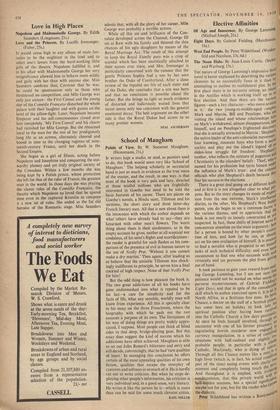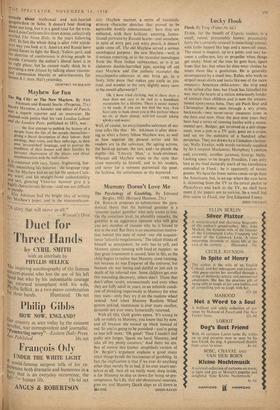Elective Affinities
The Neon Halo. By Jean-Louis Curtis. (Seeker and Warburg, 15s.) THE nature of George Lamming's impressive third novel is better explained by describing the various elements he so successfully fuses in it than by attempting to outline its multilateral plot. In the, first place there is its intrusive setting, an island in the Antilles which is working itself up to its first election. And then there are the various figures—each a key character—who move around in it : the two young-to-middle-aged couples' Mark and Marcia, Bill and Penelope, who are visiting the island and' whose relationships turn on Mark's withdrawal, aln'iost disappearance, into himself, and on Penelope's frightened discover; that she is sexually attracted to Marcia : Shepharu' the native leader of the anti-colonialist movement four knowing, innocent boys who form a secret society and play out the island's legend of 011 olden-time struggle for freedom': Shephard'As mother, who reflects the mixture of paganism an Christianity in the islanders' beliefs : Thief, who is named for his profession but turns honest under the influence of Mark's trust : and the colonial officials who plot Shephard's death because 1116 fear his success in the elections. • • There is a great deal going on at different levels' and at first it is not altogether clear to what On' pose. But as the story changes its mode of exPresi sion from the one extreme, Mark's intellectual diaries, to the other, Ma Shephard's West MOn patois, you do begin to see a common factor to the, various themes, and to appreciate that the book is not nearly as loosely constructed as Y°o 0 suspected. In fact, these shifts of interest serve 'w 'w concentrate attention on the main argument : ho far a person is bound by other people's evolve,: tion of him, and how far he can, or shottlui act on his own evaluation of himself. It is unnslf to find a novelist who is prepared to set hints% tasks of such technical difficulty; and even 111°'h uncommon to find one who succeeds with stt.e virtuosity and yet prevents the plot from getting out of hand. It took patience to gain your reward from reads ing George Lamming, but I am not sure In; patience would not be wasted on what seems t .5 perverse mysteriousness of Gabriel Fieldtte Eight Days; and that in spite of the consider(' in skill which its author exercised upon it. It is setro, North Africa, in a fictitious free zone. Its he(i'ri 5, Chance, a doctor on the staff of a Scottish Pets;i has come here on holiday to look into,of spiritual position after having been reeeli„, into the Catholic Church a few days previonsa'n At once he finds himself involved, throuBb encounter with one of his former prisoners' in ingratiating Jewish murderer now engage .ved currency manipulation, in a series of contrl, situations with half-realised and slightly ,ni probable people; in particular with a craw. Catholic, MacGrady, who is dying of cane Through all this Chance moves like a man,ftinn high fever (which is, in fact, his actual coo' one part of the time) seeing events with claritY oa, moment and completely losing touch the. Piing And throughout it is implied, with Wit! its condescension, that this private world Witttrice, half-hidden tensions, has a special signifie300 maybe'not for you, but for the reader who Icti
the dialectic.
Peter Wildeblood has written a Runyonesclue "edY about ineffectual and soft-hearted gangsterdom in Soho. It doesn't bear thinking about too long, but it is a good read for the train. Jian-Louis Curtis sets five short stories, collectively entitled The Neon Halo, in the years following 1995. In fact the whole thing is after 1984 which- ever way you look at it. America and Russia have joined forces to fight the Black/Yellow peril, and the doctrine of conformism is driving people to suicide. Certainly the author's liberal heart is in its right place; but he cannot really think he is providing a new frisson by talking about vitamin- ised communion biscuits or advertisements for Semen A.1; man, that's yesterday.
GEOFFREY NICHOLSON







































 Previous page
Previous page